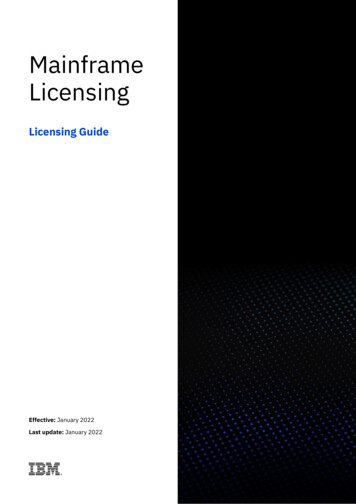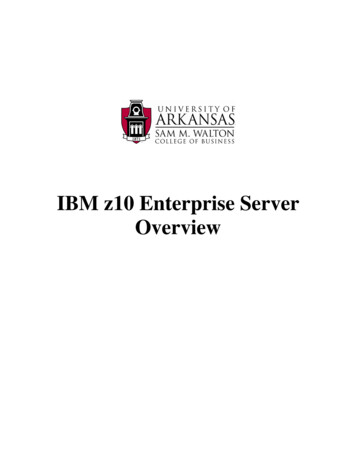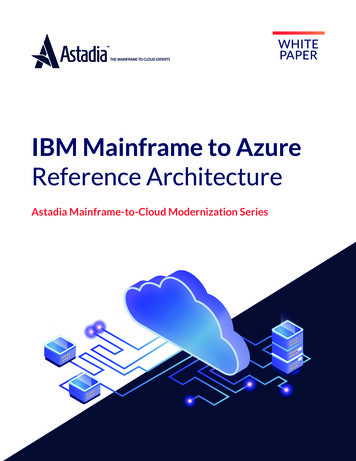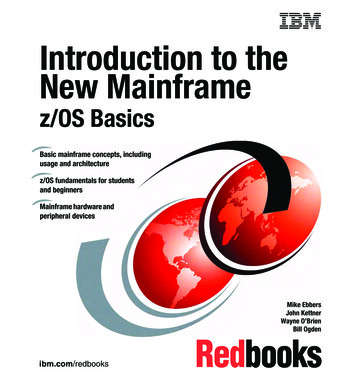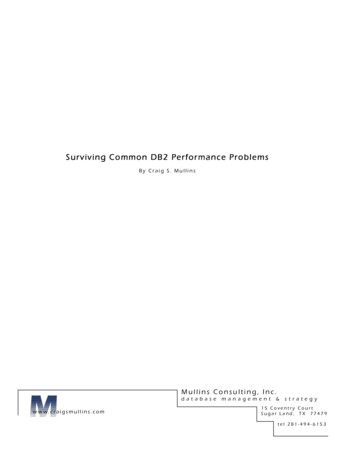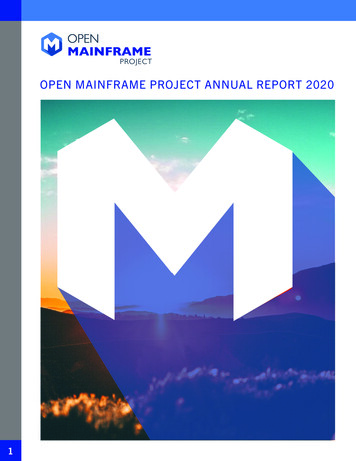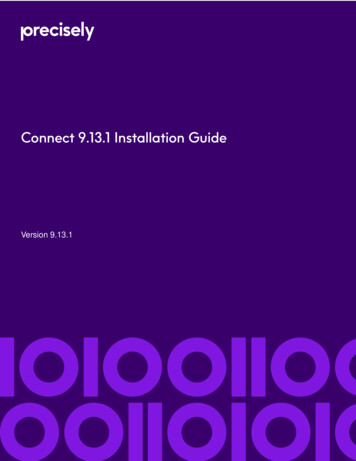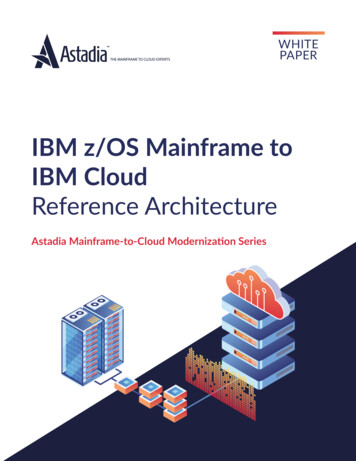
Transcription
WHITEPAPERIBM z/OS Mainframe toIBM CloudReference ArchitectureAstadia Mainframe-to-Cloud Modernization Series
AbstractIn businesses today, across all market segments, cloud computinghas become the focus of current and future technology needsIn this document, we will explore:for the enterprise. The cloud offers compelling economics, the Why modernize an IBM mainframelatest technologies and platforms and the agility to adapt yourinformation systems quickly and efficiently. However, manylarge organizations are burdened by much older, previous- The challenges associated with IBMmainframe modernizationgeneration platforms, typically in the form of an IBM mainframe An overview of the IBM mainframecomputing environment. The IBM mainframe to IBM Cloud ReferenceAlthough old and very expensive to maintain, the IBMmainframe platform continues to run the most importantinformation systems of an organization. The purpose of thisreference architecture is to assist business and IT professionalsas they prepare plans and project teams to start the process ofmoving IBM mainframe-based application portfolios to the IBMCloud. We will also share various techniques and methodologiesthat may be used in forming a complete and effective LegacyArchitecture An overview of IBM Cloud services A look at the Astadia Success MethodologyThis document is part of the Astadia Mainframeto Cloud Modernization Series that leveragesAstadia’s 25 years of mainframe platformmodernization expertise.Modernization plan.2IBM Z/OS MAINFRAME TO IBM CLOUD REFERENCE ARCHITECTURE
Table of ContentsIntroduction. 4Why Should We Migrate Our IBM Mainframe Applications to the IBM Cloud?. 5Benefits of IBM Mainframe Modernization. 5Approaches to IBM Mainframe Modernization. 5Challenges of IBM Mainframe Modernization . 6Why IBM Cloud?. 7Achieving the Positive Impact of Change. 7Understanding Typical IBM Mainframe Architecture. 8IBM Mainframe Heritage. 8IBM Mainframe Components. 9IBM Mainframe to AWS Reference Architecture. 10Understanding the IBM Cloud. 14Ensuring Project Success. 17Astadia Mainframe-to-IBM Cloud Success Methodology. 17Conclusion. 193IBM Z/OS MAINFRAME TO IBM CLOUD REFERENCE ARCHITECTURE
IntroductionThe IBM Cloud computing platform is an excellent target environmentapplication, database, technology platform and business user profilefor transitioning from an IBM z/OS mainframe workload to a cloudcurrently in use. Once completed, the results of this applicationimplementation. With the security features of IBM Cloud and therationalization will then guide the sequence of application migration,ability to scale based on demand for the services, IBM Cloud offersas well as the different modernization strategies and techniques thata complete operational environment in support of z/OS mainframemay be called upon over the course of the entire project. We’veworkloads that have been migrated to the cloud. In addition, IBMincluded an overview of how Astadia tackles Legacy ModernizationCloud supports new innovation of the application portfolio, previouslyprojects with our Success Methodology to give you an idea ofheld captive by the inflexible nature of a z/OS mainframe computingwhat’s involved.model, improving the productivity of application developers andsupport personnel.Don’t let the enormity and importance of an IBM z/OS mainframemodernization project deter you from getting started. The skilledEven more than a typical IT project, planning to modernize IBM z/individuals needed to continue to maintain mainframes areOS mainframe applications is the most important phase of the totalincreasingly leaving the workforce through retirement and areproject effort. A good place to begin is with a thorough assessmentnot being replaced. Hardware and software maintenance costsof the existing overall IBM mainframe application portfolio. Throughcontinue to escalate and the demands of customers, employeesthe assessment process, all aspects of the existing portfolio will beand partners require greater innovation than IBM z/OS mainframeinventoried and examined in detail, resulting in a catalog of eachplatforms can support.How to UseThis ReferenceArchitectureBegin by reading the “Why Should I Migrate” sectionfirst. From there: Mainframe Experts: Skip to the IBM z/OS Mainframe to IBMCloud Reference Architecture and the Understanding IBM Cloudsections. IBM Cloud Experts: Start with the Understanding IBM z/OSMainframes section, followed by the Reference Architecture. Business Leaders: Spend time with the “Why Should I Migrate ”section and the Ensuring Project Success section at the end.About AstadiaAstadia has been in the legacy modernization business since 1994 and has successfully completedmore than 200 mainframe modernization projects. Our repeated success has allowed us to developa comprehensive methodology, proprietary software tools and techniques, as well as the “knowhow” that comes with more than 25 years of experience handling mission critical applications anddata. We’re pleased to share some of that experience with you through our Mainframe to CloudModernization Series of reference architectures, webinars, whitepapers and more. Visit our website atwww.astadia.com for additional information.Visit our website at www.astadia.com for additional information.4IBM Z/OS MAINFRAME TO IBM CLOUD REFERENCE ARCHITECTURE
Why Should We Migrate Our Mainframe Apps to AWS?Over the past 10 years, public cloud computing has emerged as the foundation of future enterprisetechnology. In terms of technology generations, mainframes are at least two generations old, perhapsthree. Yet, they still survive today and are responsible for running key financial, healthcare and other vitaland sensitive systems around the world.So, why should you migrate your IBM z/OS mainframe workloads, why migrate them to the IBM Cloudand why is now the right time?Benefits of Mainframe ModernizationReuse – Often called “lift and shift.” this is a process that reuses theThe specific benefits in moving any IBM z/OS mainframe workloadexisting code/program/applications, typically written in COBOL, bywill vary between organizations and even at the application anddatabase level. In general, here are three of the top reasons drivinglegacy modernization projects today:Cost – The economics of IBM Cloud computing are compellingwhen compared with the status quo of maintaining an IBM z/OSmainframe environment. A total cost of ownership (TCO) evaluationmoving them off the mainframe and recompiling the code to run inan IBM z/OS mainframe emulator hosted in an IBM Cloud instance.This approach minimizes the upfront risks and the length of theproject, realizing hardware and software cost savings soonest.Running IBM z/OS mainframe applications in an IBM Cloud-hostedemulator also opens the possibility of new innovation leveragingof the subscription-based, consumption-driven cost model of theAPIs to previously inaccessible programs and data.cloud versus the exorbitant hardware and software maintenanceRewrite – It may be tempting to say, “Let’s just write new programscosts of mainframes will show a very appealing and short-termfrom scratch,” to modernize the IBM z/OS mainframe applications.achievable ROI (potentially less than 12 months from projectThis approach is extremely risky and fails a vast majority of thecompletion).time. It is complex, costly and time consuming. The resources andPeople – IBM z/OS Mainframe-specific technical skills are not beinginvestment required tend to greatly exceed the forecast.replaced by today’s college or technology trade school graduates.A new, modern codebase may still be the correct end objective, butThe pool of available talent with relevant knowledge and experiencea better approach would be to first move the applications to an IBMis shrinking exponentially each year. The IBM Cloud leveragesCloud-based emulator, migrate the database to an IBM Cloud-basedmodern technology and its use is ingrained into young softwaredatabase, then focus on replacing modules/code over a deliberate,engineers worldwide.multi-phased approach. When it is time to rewrite, there are severalFlexibility – The IBM Cloud offers an Open Systems environmentcode transformation engines you can choose from to reduce thein which high productivity and rapid innovation happen at aeffort and minimize the risk.tremendous rate. A properly designed implementation of an IBMReplace – Another IBM z/OS mainframe modernization approachCloud infrastructure scales easily and quickly, both expandingis to completely replace the mainframe functionality with a programand collapsing to synchronize with business demand. Backup,or suite of programs, typically a Software-as-aIBM z/OS Mainframeredundancy and disaster recovery is seamless. Support for multipleto IBM Cloud Reference Architecture 2019 Astadia, Inc. 3 Serviceend-user platforms and devices is inherent. Database sharing across(SaaS) application. You typically see this with purpose-built solutionsthe enterprise with high performance is achievable.for finance, human resources, manufacturing, enterprise resourceApproaches to Mainframe ModernizationYou may notice throughout this document that we use the terms“Mainframe Modernization” and “Mainframe Migration.” Migrationis a type of modernization, whereas modernization encompasses abroader set of strategies or options. In many cases, you will employa combination of these strategies, the right mix of which ones willbe determined during the critical application portfolio rationalizationstep of the project’s assessment phase. Here are three of the mostcommon approaches:5planning, etc. There are also industry-specific apps that may solvethe problem that a custom IBM z/OS mainframe solution wasneeded for decades ago.The upside of using SaaS is that your organization no longer worriesabout maintaining code. However, you will find that while you canconfigure a SaaS application with various options provided by thevendor, you will not be able to customize your instance, as theshared codebase runs all tenants (customers/organizations) usingthe “service.”IBM Z/OS MAINFRAME TO IBM CLOUD REFERENCE ARCHITECTURE
There are additional variations on these three modernizationapproaches and you’ll likely use several strategies in achievingyour goal to completely migrate from the IBM z/OS mainframe. Itis commonly accepted best practice among legacy modernizationpractitioners to primarily use the lower-risk, lower-cost Reuseapproach first to capture the gains and benefits in the shortest timepossible, followed by a deliberate and phased approach to Refactor,Rewrite or Replace the applications.Challenges of Mainframe ModernizationRunning Parallel SystemsFor a short while, there may need to be some parallel processingbetween the IBM z/OS mainframe application, while it is still beingused in production, and the newly migrated system, on the newplatform. Planning and executing thisparallel processing will be a challenge, and will require extra timeand attention to make it successful.Another example of when you may choose to run parallel systemsis if you want to achieve quick reductions in IBM z/OS mainframeMainframe migration projects are complex and require closeprocessing consumed by moving the development and testmanagement of the process, budgets and timelines that haveenvironments to an IBM Cloud while keeping the production systembeen set as project goals. A Reuse approach will involve re-hostingon the IBM z/OS mainframe for the interim.(from an IBM z/OS mainframe to the IBM Cloud) and likely someData Integrityre-engineering and refactoring to complete an entire IBM z/OSmainframe migration. It will also involve data and file conversions fortransitioning the database to the IBM Cloud.As we’ve been emphasizing, the first challenge of any IBMz/OS mainframe modernization project is to develop a rock-solidplan built upon a thorough application portfolio assessment andrationalization. As you put your plan together and begin to execute,Moving the contents of large databases is very challenging on anumber of levels. Typically, a database “cleanup” will be necessary toensure that the contents of the new target database is as accurateand complete as possible.An IBM z/OS mainframe modernization project is a good time totransform, correct and validate the organization’s data.here are additional factors you’ll need to watch out for:Speed to CompletionDocumentationIn almost every project, speed will be a top priority. The costs andMany IBM z/OS mainframe environments with large and complexapplication portfolios do not have documentation that details whatthese IBM mainframe applications do, and how they do it. Manyapplications are decades old, so the original system, with changescomplexities of extended project cycles can have an enormousnegative impact in tangible and intangible terms. As project cyclesget extended, staff attrition can become a big issue and staff fatiguemay also become a factor.likely every year, has become a maintenance challenge. The externalPaying for a continuation of the primary production system andinteraction with these systems, the Input/Output, is how thesefunding the development efforts of the new system at the samesystems get defined to the business, and the rest of the system istime will have a temporary financial impact for as long as that dualityjust a black box.continues. Getting to a “go live” status quickly and efficiently withMigrating a minimally documented system of this nature is trickyand the testing prior to the “go live” deployment is critical tothe new system and retiring the old system will keep unexpectedcosts to a minimum.mitigating this issue. (And, of course, copious documentation shouldProject Fundingbe captured for the resulting system.)It is very important for any modernization project to be properlyApplication-Specific Challengesfunded and supported by the business management team and theThere are a couple of general points about the applicationportfolio that should be noted. As mentioned above, the lack ofdocumentation on these aging systems makes the migration effortmore difficult. The project team that drives a migration projectexecutives. This support is essential to maintain project continuityand funding throughout the project cycle. Since we stated earlierthat speed will be a factor in the project execution, funding must bein place to sustain that speed.must then resort to “mining” the actual application source code toExpertisedetermine exactly the behavior of the application.IBM z/OS Mainframe migration projects come in many forms. InAnother important application-specific issue for consideration isevery case, a variety of specialist skills will be needed on the projectdiscovering the integration requirements and dependencies of theteam. These specialists may include business analysts working toapplication with other systems and databases. These integrations“harvest” and understand the business rules embedded in the legacyand dependencies must be clearly identified and, if still needed, theyapplications.must be reconnected (possibly rebuilt) and made operational alongwith the migrated system.6IBM Z/OS MAINFRAME TO IBM CLOUD REFERENCE ARCHITECTURE
Flexible – You can select from a wide variety of virtual environmentswhere you choose the software and services your applicationrequires. If you find that the environment selections are notadequate, you can simply provision different types of instances oradd compute and/or storage on demand.Cost-Effective – IBM Cloud services are billed in a consumptionmodel, where you only pay for the compute and storage resourcesyou use with no upfront commitments and contracts. Alternatively,if you know you have a minimal level of needs, you can sign longerterm contracts for additional savings.Reliable – With the IBM Cloud, you are taking advantage of itshighly redundant, worldwide computing infrastructure that is built toguarantee high availability that rivals or exceeds what you’ve comeIt will also include experts in specific programming languages,databases, networks, terminal devices and many other componentsof the total application portfolio that will need to be addressed overthe course of the migration to the IBM Cloud platform. Staff mustalso be available to address any specific functionality or use case ofthe IBM z/OS mainframe application environment.All this technology must be transferred to the equivalentfunctionality on the target IBM Cloud platform and work as it did inthe original IBM z/OS mainframe environment. Thorough testing bythe project team, followed by testing among the business users ofthe original IBM z/OS mainframe application system, is an absoluterequirement. Once testing is completed, a final performanceand tuning (P&T) exercise will ensure that the new IBM Cloudto expect from IBM z/OS mainframes.Scalable – The IBM Cloud includes features such as Auto Scalingand Load Balancing that allow your application to scale up or down,if you design/architect this into your solution. IBM Cloud’s massivecompute and storage infrastructure guarantees that resources willbe available when they are needed.High Performance – IBM Cloud offers a wide selection of computeand storage options to replicate or exceed the performance needsof your formerly IBM z/OS mainframe-based applications. Computeand storage can be provisioned as they are needed, so if yourapplication is CPU intensive you can have a larger CPU/IO ratio andvice versa.Secure – IBM Cloud provides several security capabilitiesdeployment is performing at optimal levels.and services to improve privacy and network response. TheseWhy IBM Cloud?encryption in transit and private or dedicated network connections.Organizations keep discovering new and improved benefits formoving their IBM z/OS mainframe (as well as other) workloads tothe IBM Cloud such as flexibility, scalability, automatic backups,automatic software upgrades, cost model optimization, versioninginclude network firewalls, IBM Cloud Virtual Private Cloud (VPC),Achieving the Positive Impact of ChangeIn any IBM z/OS mainframe migration project, the results of acloud-based application set may be daunting. The change willcontrol and adding multiple security layers, just to name a few.impact the technical staff, as they will likely need to learn new skills.The IBM Cloud is a recognized leader in the public cloud segmentThe end-user community may not notice too many changes using awith a diverse customer base and a broad range of use cases. Theyalso have the largest compute capacity in use by paying customers.This attracts open source and application developers as well asnew system if the interfaces are preserved. In fact, the move to thecloud could fuel innovation resulting in new capabilities down theroad, which are likely not available to IBM z/OS mainframe usersservice providers to make their applications compatible or add theirtoday.services to the IBM Cloud.The overall impact of a successful IBM z/OS mainframe migrationThe benefits of migrating your IBM z/OS mainframe to theproject is a positive one for the entire organization. A new andIBM Cloud are:Easy to Use – IBM Cloud is designed with simplicity in mind. Youcan request new services and host your applications using theirsimple-to-use web-based IBM Cloud Management Console. All theirservices are well documented and there is a wealth of forums, whitepapers and discussion boards.7better application portfolio, a cloud platform to enable innovation,and a large cost savings in the operational and systems softwaremaintenance categories will be realized. It’s not unusual torepurpose IT staff after redeploying the IBM z/OS mainframeportfolio to the cloud. The IBM Cloud platform has many otherbenefits, but flexibility and cost takeout are at the top of the list.IBM Z/OS MAINFRAME TO IBM CLOUD REFERENCE ARCHITECTURE
Understanding Typical IBM z/OS Mainframe ArchitectureSince their development in the late 1940s, general-purpose IBM mainframes were the computingworkhorses for more than 50 years. Over that time, each IBM mainframe has been continuouslyenhanced such that their unique architectures outperform competitors and meet evolving businessdemands. IBM eventually dominated the market and became the gold standard of mainframe computing.This IBM z/OS Mainframe to IBM Cloud Reference Architecture is part of the Astadia Mainframe-toCloud Modernization Series of architectures, whitepapers and webinars.IBM Mainframe Heritageoperating systems. Instead of these very expensive machinesIBM began producing mainframes in 1952. These early models,sitting idle while operators loaded jobs manually, programs could beknown as the IBM 700 Series, were based on vacuum tubetechnology. The next generation, IBM 7000 Series, saw theexecuted using a queuing mechanism to improve efficiency and ROI.IBM-provided software quickly grew in its complexity and becameintroduction of transistor technology and became the mainstayan important piece of IBM mainframe computing solutions.of their mainframe business for many years, with some modelsThe System/360 also consolidated support for processingremaining in service up to the 1980s.features, like decimal arithmetic, floating-point arithmetic, and byteIn 1964, IBM announced availability of the System/360, with theaddressing. These features were previously available only in models“360” representing the idea of 360 degrees – as in, an all-aroundbuilt for specific purposes like business or scientific calculations.computing system. Previous IBM mainframes were delivered withAs technologies and software advanced, newer models wereno software since it was expected that the customer would write allreleased as System/370 and System/390, culminating in the 64-bitprograms. These programs were loaded and executed manually, oneeServer zSeries, z Systems, and IBM’s current line of zEnterpriseat a time.mainframes. The “z” refers to “zero downtime” since the models areWith the release of the System/360, IBM delivered software suchbuilt with components that provide hot failover capabilities.as compilers for programming languages (e.g., COBOL) and earlyIBM MAINFRAMEBatchCICSIMSASM, COBOL, PL/I, Natural, Fortran, JCL, REXX, etc.SchedulerPrint & SortInterfacesCodeVersioningData Files(VSAM, GDGs, etc.)DB MGT &ReportDatabaseCustom UI(DB2, IMS, Adabas, etc.)SecurityTN3270 Screensz/OSLPAR8WebIBM Z/OS MAINFRAME TO IBM CLOUD REFERENCE ARCHITECTURE
IBM Mainframe ComponentsUSER INTERFACESUsers access the mainframe application through a variety of means.They could use green screen terminal emulators that providecharacter mode interface (TN3270).Alternatively, a variety of custom user interfaces could be built ontop of the character mode interface that allows a more user-friendlyinterface to IBM z/OS mainframe applications. One such userinterface could be a web-based or mobile application serving as afront end to the IBM z/OS mainframe.BATCHIBM z/OS mainframes provide batch environments that handle bulkdata processing workloads. Jobs are submitted to the system usingJCL and processed with minimal operator interaction. Output fromthe batch jobs is spooled, printed and distributed to users.TRANSACTION PROCESSINGTransaction processing is at the core of most mission-criticalapplications with thousands or millions of transactions beingprocessed daily. IBM z/OS mainframes provide online (real-time,on-demand) processing environments (most commonly CICS andstored in EBCDIC (Extended Binary Coded Decimal InterchangeCode), an eight-bit character encoding system used primarily onIBM mainframes.DATABASESIBM z/OS mainframes provide high performance databasemanagement systems to support online mission-critical applications.In general, these databases can be hierarchical (IMS/DB) orrelational (DB2), and they provide high levels of availability, integrity,consistency, reliability, security and auditing.Database software makes intensive use of the computing and input/output capabilities of the mainframe to provide optimal responsetimes. IBM offers specialized processors for database workloads toreduce the burden on general processors.ENVIRONMENTAL SOFTWAREIBM mainframes require software to support the management,operation, application development and security of the system.Software tools like IBM’s Time Sharing Option (TSO) and InteractiveSystem Productivity Facility (ISPF) are used by administrators andprogrammers to create, store, print and delete datasets as well assubmit batch jobs.IMS/DC) that make this possible. Security, transaction integrity andJob scheduling software is used to automate and manage batchpredictable response times are of particular importance for this typejob execution and workflow streams. Output management systemsof workload.handle the collection, storage and distribution of reports to users.PROGRAMMING LANGUAGESIBM z/OS mainframes provide an assortment of programminglanguages to suit customer needs. Most applications are writtenin COBOL but other languages are also used: IBM Assembler,PL/I, Software AG’s Natural, Fortran, REXX, etc. 4GL developmentproducts like Cincom’s Mantis, Informix 4GL, and APS (AppMaster)are also used to develop IBM z/OS mainframe applications.DATA FILESMainframes store data in files with different record organizationsand media types. Data files can be sequential, direct access, fixedand variable lengths, blocked or unblocked, etc. Data files can bestored on disks, magnetic tapes, CDROMs, etc. Some examplesinclude VSAM and ISAM. For the most part, data in these files are9Source management systems are used to maintain applicationsource code by tracking version as well as release lifecycles.Terminals and terminal emulation software allow users tointeract with mainframe software and applications. The 3270communication protocol is used to communicate between the IBMmainframe and a terminal session.Security is tightly controlled at all levels of the mainframe software.Software provided by IBM, such as Resource Access ControlFacility (RACF) and Access Control Facility 2 (ACF2) by ComputerAssociates, cooperate with system components to provide a robustyet secure environment for applications and data. Security softwareis designed to minimize the risk of data exposure and provideregulatory compliance.IBM Z/OS MAINFRAME TO IBM CLOUD REFERENCE ARCHITECTURE
IBM z/OS Mainframe to IBM Cloud Reference ArchitectureAs a Reference Architecture, the following discussion addresses a typical use case. However, eachimplementation is sure to have its own customizations and variations, which is why a thoroughapplication portfolio inventory, assessment and rationalization is critical to a successful outcome.Any design will include details such as IBM Cloud components, batch requirements, programminglanguage conversions and replacements, integration with external systems, third-party softwarerequirements and planning for future needs.In an actual project, you would also consider any unique features that would necessitate custom-madesolutions. We would recommend proof-of-concept conversions on application subsets to test the modelselected, discover any weaknesses and prove the viability of the design.Code ModificationAs part of any mainframe modernization project, there will be aneed for partial or, in some cases, extensive code modification.code migration filters ensure the preservation of mission-criticalapplications and back-end components such as transcodes, securitypolicies, and message routing.Leveraging our past experience in migrating IBM z/OS mainframesThough the Rules-Based Transformation Engine (RBTE) is a provento on-premises open-systems platforms, Astadia has developed antechnology, Astadia augments our technology with years of hands-extensive set of code transformation technologies and processeson migration experience and collaboration with partners. Theto successfully replatform mainframe workloads. We use these incombination of automation and human intervention ensures thatconcert with trusted third-party products to modify source code forlegacy applications will work in the IBM Cloud without sacrificingdeployment to the IBM Cloud. What follows is a description oftheir original functionality.our approach.Although every IBM z/OS mainframe migration is unique, there areAstadia employs an iterative, hybrid process of automated codegeneral source-to-target mappings for application components thatconversion and human intervention. The technology behind theapply to most projects, as shown in the following table.automation is our Rules-Based Transformation Engine.This tool preserves the business logic and rules of legacyapplicatio
7IBM OS MAINFRAME TO IBM CLOUD REFERENCE ARCHITECTURE It will also include experts in specific programming languages, databases, networks, terminal devices and many other components of the total application portfolio that will need to be addressed over the course of the migration to the IBM Cloud platform.
